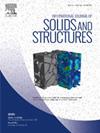Unified characterization of failure surfaces and golden-ratio ductile-to-brittle classification for isotropic materials
IF 3.4
3区 工程技术
Q1 MECHANICS
International Journal of Solids and Structures
Pub Date : 2024-12-03
DOI:10.1016/j.ijsolstr.2024.113184
引用次数: 0
Abstract
The failure surface, often referred to as the failure angle, defines the specific planar orientation within a material that reaches its load-carrying capacity, represented by material strengths. Analyzing this critical surface is elemental for material characterization, providing profound insights into ductility and brittleness. Despite the diversity of methodologies employed for determining the failure plane from various criteria, a universally accepted theory that systematically governs this characteristic across a broad spectrum of isotropic materials remains elusive. Therefore, this paper aims to develop a unified framework for predicting the failure surface for all homogeneous isotropic solids by considering the convergence of three key material constitutive models: elasticity, failure, and plasticity. A universal energy-based failure criterion is utilized to determine failure angles under fundamental loading scenarios, including uniaxial tension, uniaxial compression, pure shear, and biaxial tension–compression. The sliding, splitting, and crushing behaviors are obtained from the direct and shear strain increments, while the ratio of the two strain increments elucidates the dominant roles in ductile and brittle failure modes. For the first time, the developed theory links the failure angle to Poisson’s ratio, and uniaxial strength properties, unveiling a connection between intrinsic material parameters and extrinsic ductility and brittleness induced by external loadings. The failure angle representing ductile-to-brittle transition under the applied stresses in the principal stress coordinates is shown to be directly related to the golden ratio and independent of loading types. This research addresses longstanding mysteries by providing a deeper understanding of the physics of solids and suggesting potential applications with a phase-field model for predicting the evolving fracture direction.
求助全文
约1分钟内获得全文
求助全文
来源期刊
CiteScore
6.70
自引率
8.30%
发文量
405
审稿时长
70 days
期刊介绍:
The International Journal of Solids and Structures has as its objective the publication and dissemination of original research in Mechanics of Solids and Structures as a field of Applied Science and Engineering. It fosters thus the exchange of ideas among workers in different parts of the world and also among workers who emphasize different aspects of the foundations and applications of the field.
Standing as it does at the cross-roads of Materials Science, Life Sciences, Mathematics, Physics and Engineering Design, the Mechanics of Solids and Structures is experiencing considerable growth as a result of recent technological advances. The Journal, by providing an international medium of communication, is encouraging this growth and is encompassing all aspects of the field from the more classical problems of structural analysis to mechanics of solids continually interacting with other media and including fracture, flow, wave propagation, heat transfer, thermal effects in solids, optimum design methods, model analysis, structural topology and numerical techniques. Interest extends to both inorganic and organic solids and structures.

 求助内容:
求助内容: 应助结果提醒方式:
应助结果提醒方式:


